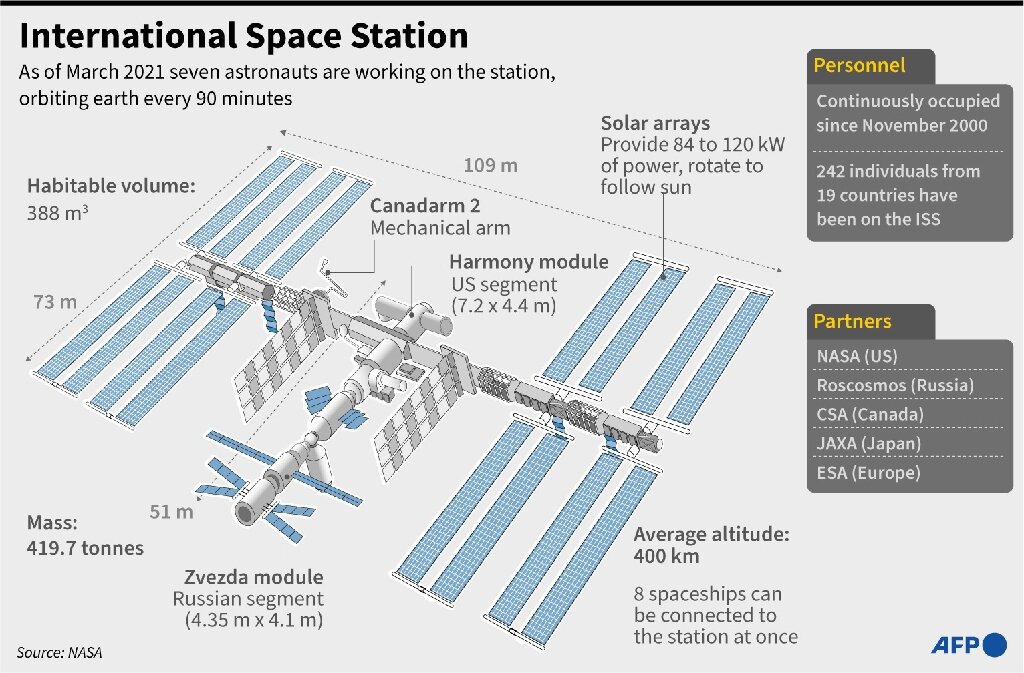
Diagram of the International Space Station showing the order in which the modules were added. Science Exploration International Space Station.

The trusses are used to support the solar arrays and radiators.
International space station diagram. Critical component of the stations Active Thermal Control System. Extends 50-feet from the station to help regulate the stations internal temperature Truss Structure. Consists of a linearly arranged sequnce of connected trusses on which various unpressurized components are mounted such as logistics carriers radiators solar arrays and other equipment.
The International Space Station is made up of many modules from the US Russia Japan Canada and ESA. A truss is a segment or part of the whole Integrated Truss Structure. The trusses are used to support the solar arrays and radiators.
The solar arrays provide energy for the Station and the radiators get rid of extra heat that builds up in the Station. When complete the Integrated Truss Structure will contain 10. ESA - International Space Station exploded diagram.
We use cookies which are essential for you to access our website andor to provide you with our services enable you to share our website content via your social media accounts and allow us to measure and improve the performance of our website. Accept all cookies Accept only essential cookies See. 4 2018 — The International Space Station photographed by Expedition 56 crew members from a Soyuz spacecraft after undocking.
NASA astronauts Andrew Feustel and Ricky Arnold and Roscosmos cosmonaut Oleg Artemyev executed a fly around of the orbiting laboratory to take pictures of the station. The 100 billion International Space Station has the wingspan of a football field and the living space of a five-bedroom house. It took more than 115 spaceflights of different kinds of spacecraft.
Diagram of the International Space Station showing the order in which the modules were added. International Space Station Facts and Figures. Space Station Images NASA.
The International Space Station is the biggest object ever flown in space. It travels around the Earth at an average speed of 27700 kmh completing 16 orbits per day. At night it can easily be seen from Earth as it flies 320 kilometres above us.
16 countries including the USA Russia Japan Canada and many ESA member states worked together to build the Station. S134-E-010590 29 May 2011 — Backdropped by Earths horizon and the blackness of space the International Space Station is featured in this image photographed by an STS-134 crew member on the space shuttle Endeavour after the station and shuttle began their post-undocking relative separation. Undocking of the two spacecraft occurred at 1155 pm.
The International Space Station is the largest man-made structure ever built in space. From end to end it is as long as a football field and can be seen from the ground by. Media in category Diagrams of the International Space Station.
The following 53 files are in this category out of 53 total. 15 Years ISS - Infographicpdf 2666 7062. 15 Years ISS - Infographicpng 5332 14122.
15th Anniversary Infographicjpg 1440 2812. A 1998 diagram of the International Space Station and the countries involved. Following the Cold War several national space programs including NASA and a Russian agency joined efforts to have a permanently inhabited research facility in space.
Station Solar Arrays and Radiator Panels Image courtesy of a NASA Expedition 38 crew member on January 2 2014 A pinpoint beam of sunlight peeks through a truss-based radiator panel and a primary solar array panel on the ISS in Figure 1. Clouds can be seen over the Earth blanketed by the cold blackness of space in the background. Features the latest news on the International Space Station ISS European participation in the ISS and ISS commercialisation.
Science Exploration International Space Station. Latest All Stories Videos Images. Science Exploration Luca powers up for a.
In 1984 President Ronald Reagan envisioned a permanent space station. Today we know it as the International Space Station. The process of assembling the International Space Station has been under way since the 1990s.
Zarya the first ISS module was launched by a Proton rocket on 20 November 1998. The STS-88 Space Shuttle mission followed two weeks after Zarya was launched bringing Unity the first of three node modules and connecting it to Zarya. This bare 2-module core of the ISS remained uncrewed for.
NASA Astronaut Sunita Suni Williams gives us the best inside tour of the International Space Station ISS. How do astronauts live on the ISS. How do they.